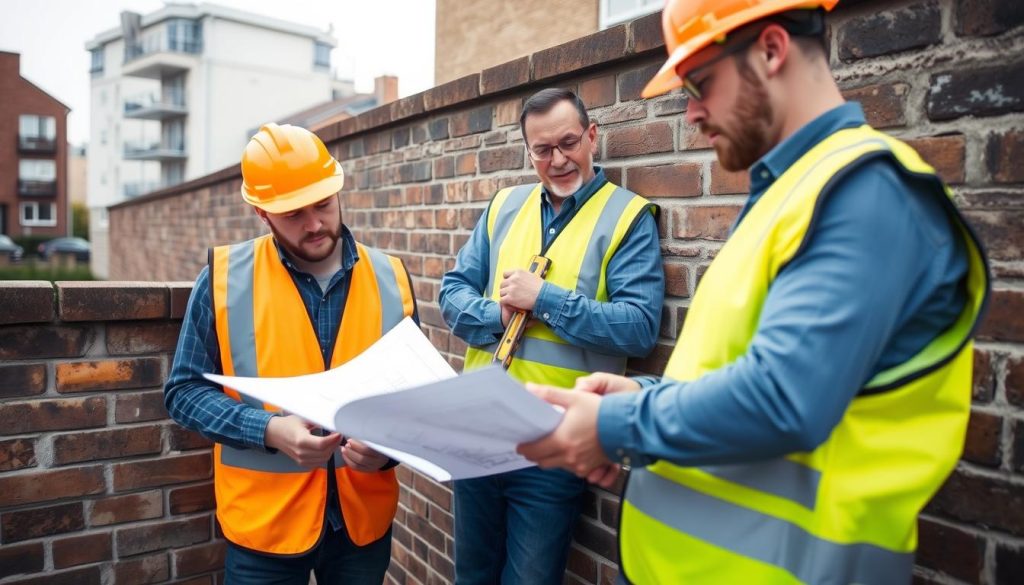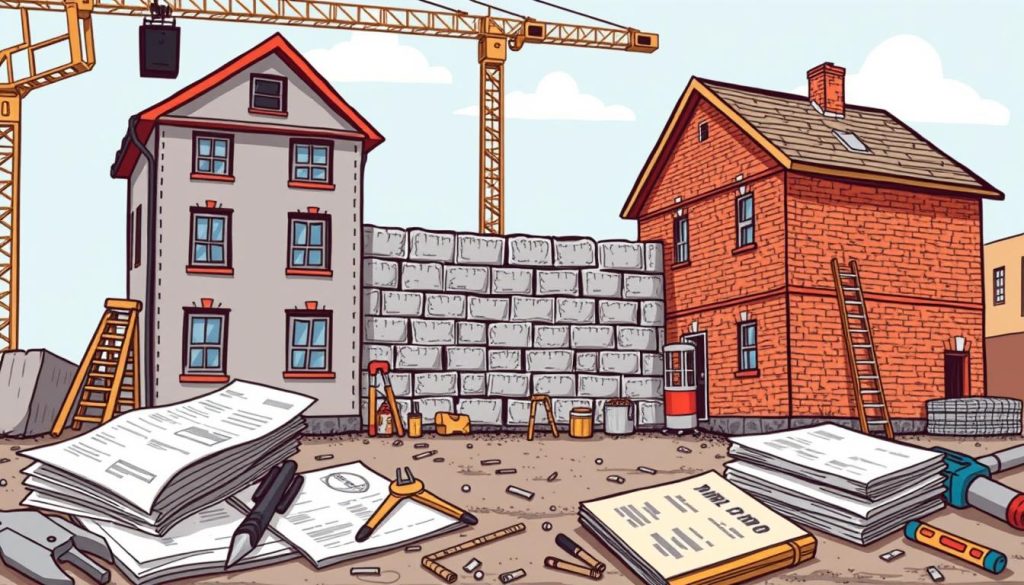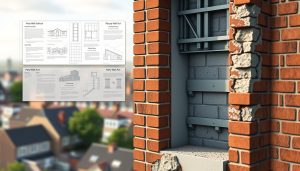Are you contemplating building works on your property that might impact a shared wall or boundary with your neighbour? Understanding the concept of party on the wall and party wall agreements is imperative. These agreements are designed to manage disputes and responsibilities between neighbours who share a party wall or boundary. They ensure both parties are protected and aware of their rights and obligations.
You may ask yourself, “Do I Need a Party Wall Surveyor?” A party wall agreement is a legally binding document. It outlines the terms and conditions of the building works. This includes the scope of the project, the responsibilities of each party, and the procedures for resolving disputes. Having a party wall agreement in place is critical to avoid conflicts and costly disputes that may arise during or after the building works.
By grasping the concept of party wall agreements, you can safeguard your property and ensure a successful building project. In this guide, we’ll walk you through obtaining a party wall agreement. We’ll cover the key steps, timelines, and costs involved. Whether you’re a homeowner, builder, or property developer, this guide will equip you with the necessary information to navigate the party on the wall process.
Key Takeaways
- Party wall agreements are essential for managing disputes and responsibilities between neighbours who share a party wall or boundary (see What is a Party Wall Dispute?).
- A party wall notice must be served between 1 or 2 months (depending on the works) to 1 year prior to the commencement of a project.
- The neighbour must respond in writing within 14 days regarding consent to the party wall notice.
- A party wall agreement can help protect your property and ensure a smooth and successful building project.
- The average total cost of a party wall award is approximately £1,000-2,000.
- Surveyors’ rates for party wall agreements range from £150 to £400 per hour.
Understanding Party Wall Agreements in the UK
In the UK, property owners must understand their rights and duties regarding party wall agreements. These agreements pertain to shared walls between semi-detached houses or those on property boundaries and the Party Wall Act 1996, applicable in England and Wales, aims to safeguard the integrity of shared walls and adjacent structures from construction damage.
For significant projects like loft conversions, extensions, and basement excavations, party wall agreements are critical. They guarantee mutual understanding of the construction activities and protect the integrity of shared walls.
What Constitutes a Party on the Wall
A party wall encompasses garden walls along property boundaries, known as party fence walls. Accurate identification of a party wall is vital to ascertain the necessity for a party wall agreement. This involves understanding the different types of party wall structures and the legal framework governing them.
Types of Party Wall Structures
Party wall structures vary, including shared walls between semi-detached houses and boundary walls. Each structure type has specific regulations, necessitating a thorough understanding to comply with the Party Wall Act 1996.
Legal Framework and Rights
The Party Wall Act 1996 establishes a framework for dispute resolution and clarifies rights and obligations. Neighbours have 14 days to respond to a party wall notice. Familiarity with the legal framework and rights is essential to prevent disputes and facilitate a seamless process.
When Do You Need a Party on the Wall Agreement
A party wall agreement is imperative when planning to undertake building work adjacent to or on a party wall. This includes projects such as loft conversions, extensions, or excavations. It is vital to ensure that such work is executed safely, without compromising the integrity of adjacent properties.
Examples of construction activities necessitating a party wall agreement include:
- Building an extension that shares a wall with a neighbouring property
- Converting a loft that involves altering the party wall
- Excavating near a boundary that may affect a shared structure
It is critical to ascertain whether a party wall agreement is required prior to initiating any construction. If in doubt, seeking counsel from a party wall surveyor is advisable. They can offer invaluable guidance and facilitate the process.
In conclusion, a party wall agreement is an indispensable document. It safeguards the interests of both property owners and ensures that construction is carried out safely. By understanding the necessity for such an agreement, one can prevent disputes and ensure a seamless construction process.
| Type of Building Work | Requires Party Wall Agreement |
|---|---|
| Loft conversion | Yes, if it involves altering the party wall |
| Extension | Yes, if it is on the boundary of a neighbouring property |
| Excavation | Yes, if it is near a neighbouring structure (within 3-6m) |
The Party Wall Act 1996: Your Legal Framework
The Party Wall Act 1996 establishes a legal framework for managing disputes and facilitating the acquisition of a party on the wall agreement. It is pertinent to England and Wales, focusing on new constructions near property boundaries. This legislation stands apart from others, such as the Town and Country Planning Act 1990 and the Building Act 1984.
Central to the Act is the mandate for building proprietors to notify adjacent owners before initiating any significant works. This notification must outline the scope of the proposed projects and the legal identities of all stakeholders. Adjoining owners have a 14-day window to respond, affirming their consent for the construction of a party wall or fence.
The Act also delineates a pathway for resolving conflicts over proposed works. A party wall surveyor is appointed to mediate disputes, crafting a legally enforceable party wall award. This document must specify the methodologies of construction, working hours, protective measures for adjacent owners, and compensation for any resultant damage.
| Party Wall Type | Description |
|---|---|
| Party Wall | A wall that stands on the land of two or more owners |
| Party Fence Wall | A wall that stands on the boundary of two properties, but is not part of a building |
| Party Structure | A shared structure, such as a floor or ceiling in flats |
Grasping the nuances of the Party Wall Act 1996 is critical for both building proprietors and adjacent owners. Adherence to the Act’s stipulations ensures the safeguarding of rights and the efficient resolution of any disputes.
Party on the Wall: Essential Steps for Agreement Success
To achieve agreement success, understanding the critical steps for obtaining a party wall agreement is imperative. The Party Wall Act 1996 governs such agreements in England and Wales, outlining legal frameworks for construction works impacting shared boundaries. The initial step involves serving a party wall notice, a requirement that must be fulfilled at least one or two months prior to the commencement of the works.
Effective communication is fundamental to a successful party wall agreement. Research highlights that open dialogue can streamline the process, with neighbourly discussions leading to a 30% decrease in disputes. Professional guidance for party wall agreements also significantly reduces conflicts, by up to 70%, compared to those without such support.
Key statistics underscore the importance of adhering to the party wall agreement process:
- Minor disputes can diminish by up to 70% when proper procedures are followed.
- The appointment of a party wall surveyor is critical in 100% of notifiable projects (see Different Types of Work for Party Wall), ensuring fair assessment and compliance.
- Approximately 50% of contested party wall agreements necessitate a degree of mediation, often resulting in increased costs and time.
For further insights into party wall surveyors and the agreement process, visit party wall surveyors websites. They offer detailed guidance on scenarios such as loft conversions, chimney breast removal, extensions, and basement conversions that may require party wall agreements.
By adhering to the essential steps and considering these statistics, you can enhance your chances of achieving agreement success and mitigating disputes. Always prioritize open communication and seek professional guidance when necessary.
Serving Party Wall Notices
Construction work that impacts a party wall necessitates the service of party wall notices to adjacent neighbours. This step is vital for ensuring mutual awareness and agreement on the terms of the party wall agreement.
Notices must be served at least two months prior to the commencement of the construction. The notice should detail the planned work, the start date, and the owner’s contact information. Including a photographic survey of the neighbour’s property is advisable to document the pre-construction state.
Notice Templates and Requirements
There are distinct types of party wall notices: Line of Junction Notice, Party Structure Notice, and Adjacent Excavation Notice. Each notice type has specific requirements, necessitating proper service.
- Line of Junction Notice: served when building up to or astride the line of junction between two properties.
- Party Structure Notice: served when undertaking work to a party wall or party structure.
- Adjacent Excavation Notice: served when excavating within 3 to 6 metres of a neighbour’s property.
Timeframes and Deadlines
Neighbours have 14 days to respond to a party wall notice. If no response is received, a follow-up letter is dispatched, requiring an additional 10 days for a reply. Absence of a response after the follow-up necessitates the pursuit of a party wall agreement.
| Type of Notice | Timeframe |
|---|---|
| Line of Junction Notice | 1 month |
| Party Structure Notice | 2 months |
| Adjacent Excavation Notice | 1 month |
Grasping the intricacies of serving party wall notices is essential for a seamless construction endeavour.
The Role of Party Wall Surveyors
In the realm of party wall agreements, the significance of party wall surveyors can not be overstated. They serve as impartial mediators, bridging the gap between building owners and their neighbours and the surveyor role encompasses several critical tasks: these include the preparation of a schedule of condition, the drafting of party wall awards, and the enforcement of compliance with the Party Wall Act 1996.
The necessity of party wall surveyors in averting and resolving construction-related disputes is well-documented. It is reported that around 75% of such disputes can be resolved amicably with their intervention. Their profound understanding of the Party Wall Act 1996 empowers them to offer invaluable guidance on the legal rights and obligations of all parties involved.

- Preparing a schedule of condition to record the existing condition of adjoining properties
- Drafting party wall awards or agreements that define the rights and responsibilities of both parties
- Ensuring compliance with the Party Wall Act 1996 and resolving disputes that may arise
The appointment of a party wall surveyor is instrumental in ensuring the smooth execution of construction projects. It guarantees minimal disruption to both building owners and their neighbours. Their expertise and guidance are invaluable in preventing costly and time-consuming disputes, streamlining the process of obtaining a party wall agreement (see What if you do not have a Party Wall Agreement?).
Common Disputes and Resolution Methods
Party wall disputes frequently occur between neighbours, often due to alterations or construction on shared structures. It is vital to understand the necessity of serving a party wall notice at least one or two months prior to commencing work. The work must commence within a year of the notice to adhere to the Party Wall Act.
A building owner must serve a party wall notice to the adjacent owner at least one or two months in advance of the proposed work. If the adjacent owner fails to respond within 14 days, a dispute is deemed to have arisen. The most prevalent dispute involves work on a shared wall without consent or refusal of consent for proposed building work.
Typical Areas of Conflict
- Issues with party wall notices
- Access to neighbouring properties
- Damage to neighbouring properties
Disputes can be resolved through mediation and legal remedies. An independent surveyor issues a party wall award, outlining work specifications, timelines, and protective measures. The timeframe to challenge a surveyor’s award is extremely short, necessitating an appeal within a few days.
Mediation
The party wall surveyor is quasi-judicial and can act as a sort of mediator, offering a cost-effective and efficient resolution to party wall disputes, beneficial for resolving issues with party wall notices, access, and damage to neighbouring properties.
Legal Remedies
If mediation fails, legal remedies may be required. The Party Wall Act outlines a framework for dispute resolution, including the appointment of a surveyor and the service of a party wall award. If dissatisfied with the award, a party can appeal to the County Court. Non-compliance with the Act can lead to legal consequences, including injunctions, damages, or compensation claims.
Costs and Financial Considerations
Understanding the costs associated with party wall agreements is vital. Party wall costs can fluctuate greatly, influenced by project complexity and the number of surveyors. Typically, the expense for a Party Wall Agreement spans from £1,000 to £3,000, with the median cost hovering around £2,000.
Several elements impact financial considerations. These include surveyor fees, construction expenses, and insurance mandates. For example, party wall surveyors’ hourly rates span from £100 to £450. The expense for a single surveyor can range from £1,000 to £3,000, whereas two surveyors’ services might cost between £2,000 to £5,000.

- Loft conversion: £1,000 to £2,000 (single surveyor), £2,000 to £3,000 (two surveyors)
- Extension: £1,000 to £2,000 (single surveyor), £2,000 to £3,000 (two surveyors)
- Basement: £2,000 to £3,000 (single surveyor), £3,000 to £5,000 (two surveyors)
It is imperative to account for these costs and financial considerations when planning a project that necessitates a party wall agreement. By grasping the possible expenses and taking measures to reduce them, you can facilitate a more efficient and cost-effective endeavour (see How to Keep Party Wall Costs Down).
Practical Tips for Maintaining Neighbourly Relations
Ensuring harmonious neighbourly relations is vital for a seamless party wall agreement process. The essence lies in effective communication and mutual cooperation. In the context of party wall agreements, communication is critical in averting disputes and ensuring collective understanding.
To foster neighbourly harmony, consider these practical suggestions:
- Inform your neighbours about your construction plans and schedules
- Respect their property and their apprehensions
- Address any issues or concerns with promptness and professionalism
Preventing disputes is the most advisable strategy, as they can incur substantial costs and delays. For example, a bill for the building owner involved in disputes can exceed £6,000 due to unresolved issues and tardy communication. By fostering neighbourly harmony, you can diminish the likelihood of disputes and streamline the party wall agreement process.
Adopting these practical tips can help maintain neighbourly harmony and ensure a successful party wall agreement process. Remember, good communication and cooperation are indispensable for a positive outcome.
| Tip | Benefit |
|---|---|
| Keep neighbours informed | Prevents misunderstandings and disputes |
| Be respectful of their property | Builds trust and cooperation |
| Address issues promptly | Resolves problems quickly and efficiently |
Conclusion: Party on the Wall Process
In summarising our detailed exploration of party on the wall agreements, it’s evident that mastering the process hinges on a deep grasp of legal principles and effective neighbour communication. The Party Wall etc. Act of 1996 delineates the rights and duties of building proprietors and their neighbours, fostering a fair and dispute-free construction path.
Through the issuance of correct party wall notices, the engagement of skilled party wall surveyors, and sustained dialogue, property holders can significantly reduce the likelihood of conflicts. A legally enforceable party wall agreement serves as a protective measure, safeguarding the interests of all stakeholders.
The essence of a fruitful party wall process lies in a cooperative effort, with both building proprietors and their neighbours collaborating to meet legal stipulations and discover common ground. By understanding the process and adhering to the requisite steps, property owners can initiate their construction endeavours with assurance, preserving harmonious neighbourly relations.
FAQ
What is a party wall agreement?
A party wall agreement is a legal document that outlines the rights and responsibilities of property owners who share a common wall or boundary. It is essential for protecting your property when undertaking building work that may affect the party wall.
What types of party wall structures are there?
There are several types of party wall structures. These include a wall that stands on the land of two (or more) owners, a wall that separates buildings belonging to different owners, and a wall that is part of one building but stands on the land of another owner.
When is a party wall agreement necessary?
A party wall agreement is usually required when you plan to carry out building work that involves a party wall. This includes cutting into the wall, building onto or above it, or even demolishing and rebuilding it. The Party Wall Act 1996 outlines the specific circumstances that require a party wall agreement.
What are the key provisions of the Party Wall Act 1996?
The Party Wall Act 1996 establishes the legal framework for party wall agreements. It includes your rights as a building owner, your obligations as an adjoining owner, and the process for serving notices, appointing surveyors, and resolving disputes.
How do I serve a party wall notice?
Serving a party wall notice involves following specific requirements. This includes using the correct notice templates, adhering to timeframes and deadlines, and providing the necessary information to your neighbour. It’s important to follow the correct procedures to ensure the notice is valid.
What is the role of a party wall surveyor?
Party wall surveyors are professionals who are appointed to help resolve disputes between property owners during the party wall agreement process. They are responsible for ensuring the work is carried out in accordance with the Act and protecting the interests of both parties.
What are the most common party wall disputes?
Common party wall disputes can include issues around the scope of work, access rights, damage to the party wall or adjoining properties, and cost allocation. These disputes can be resolved through mediation or legal remedies outlined in the Party Wall Act 1996.
What are the financial considerations for a party wall agreement?
The financial considerations for a party wall agreement can include surveyor fees, construction costs, and insurance requirements. It’s important to budget for these expenses and understand your obligations under the Act.
How can I maintain good neighbourly relations during the party wall agreement process?
Maintaining good neighbourly relations is essential during the party wall agreement process. This involves open communication, respect for each other’s rights and concerns, and a cooperative approach to resolving any issues that may arise.
















